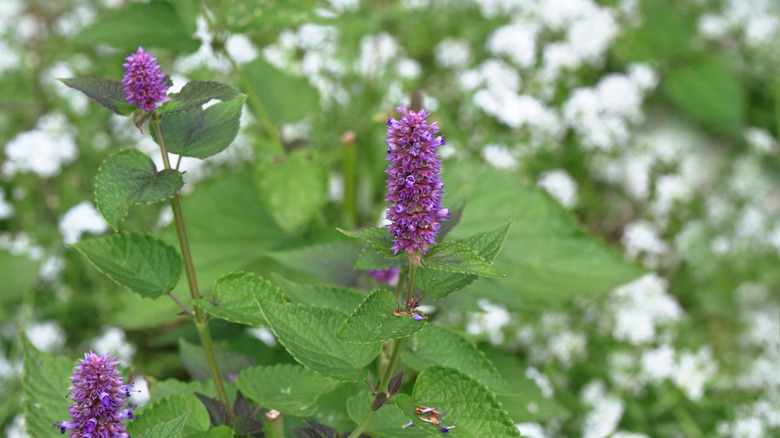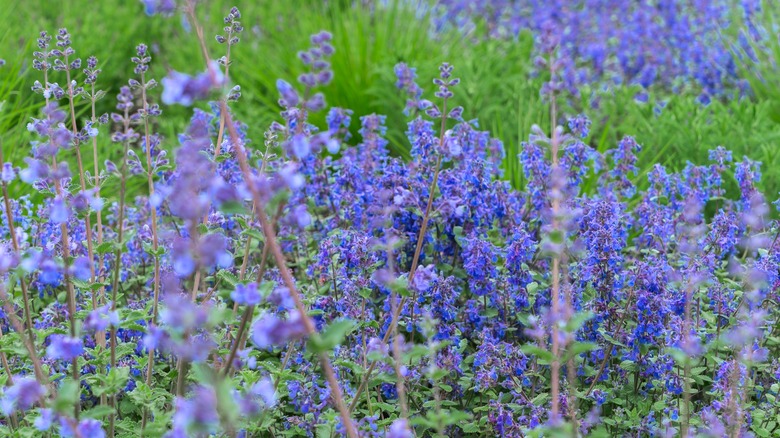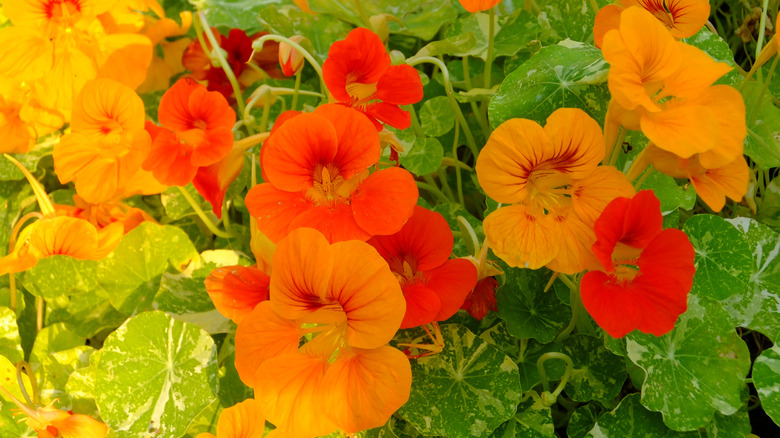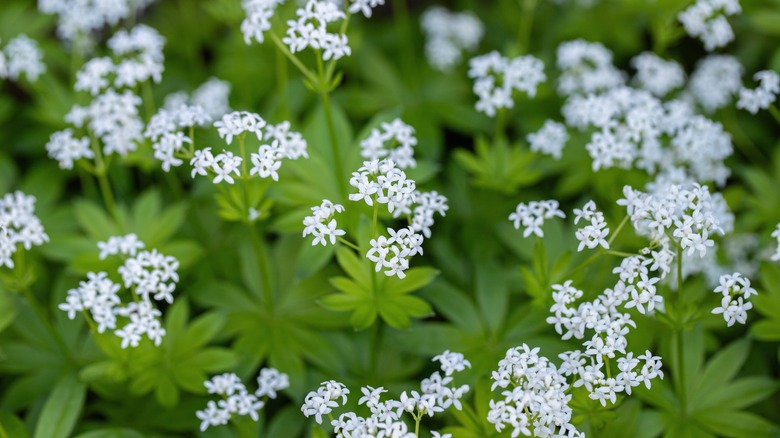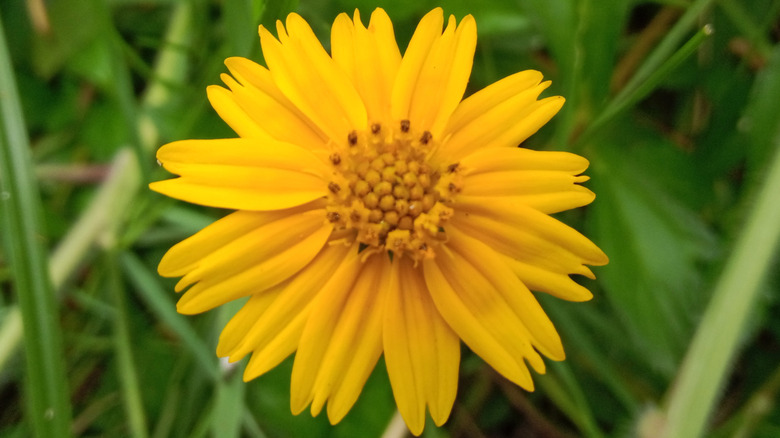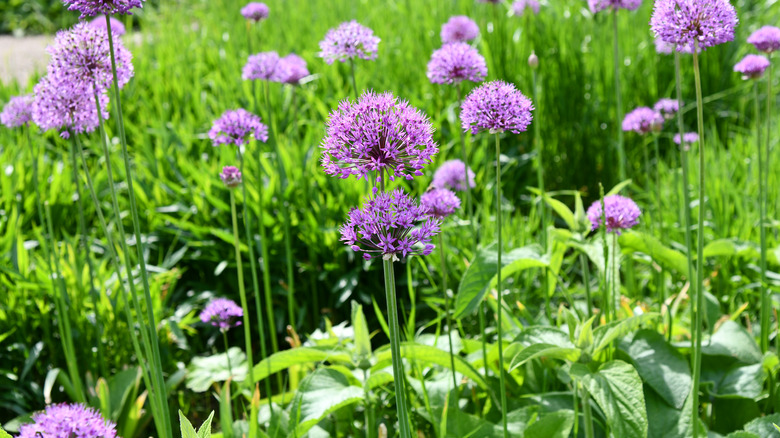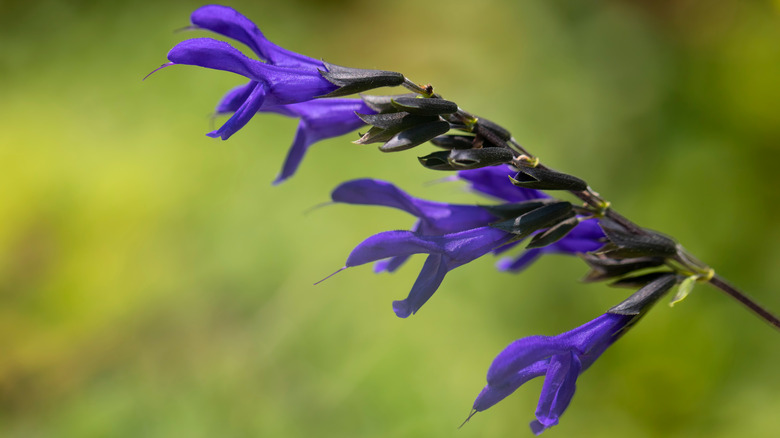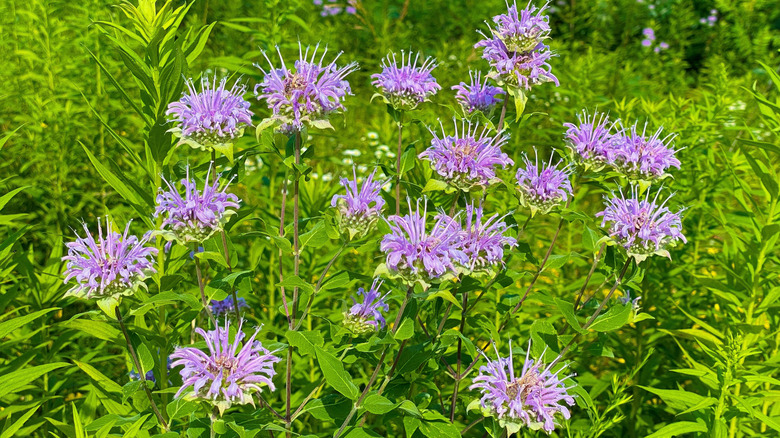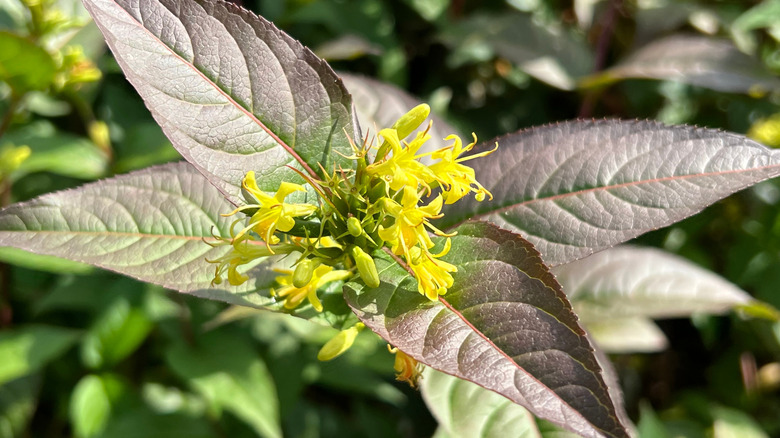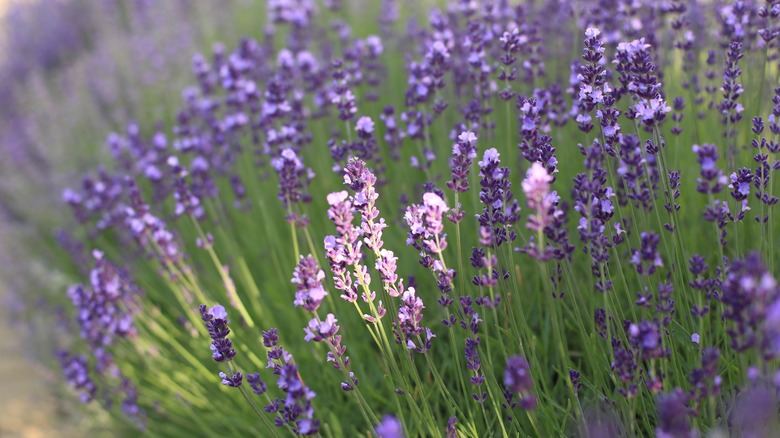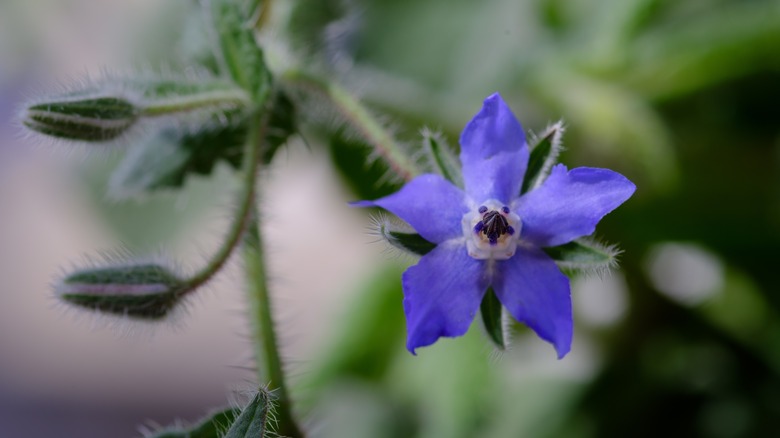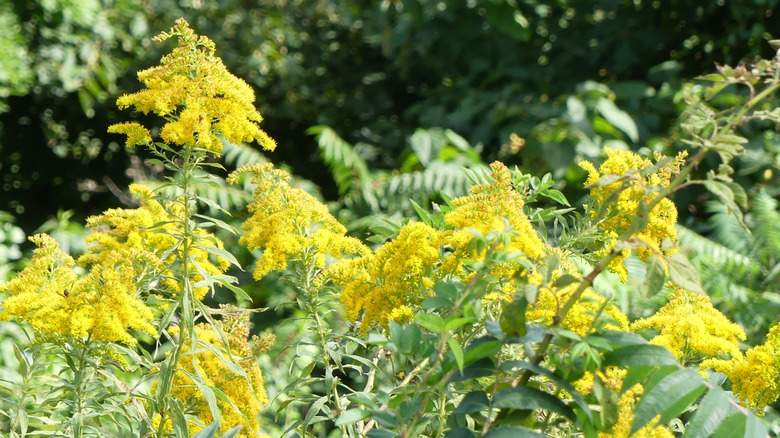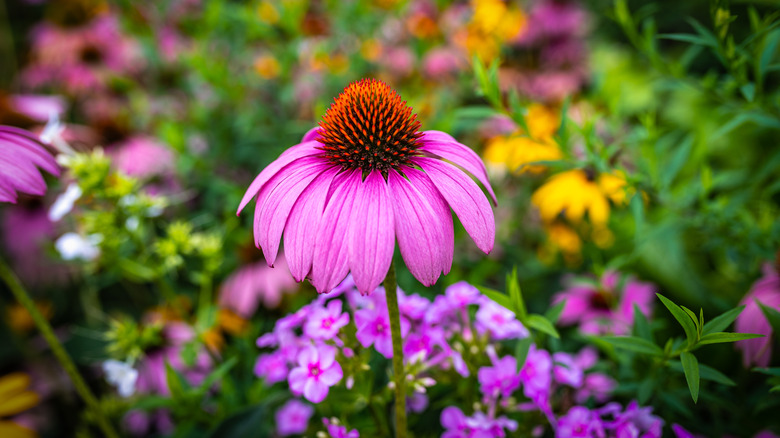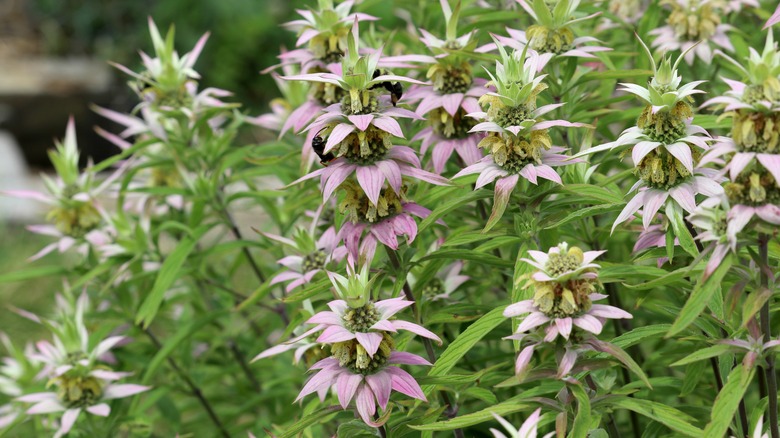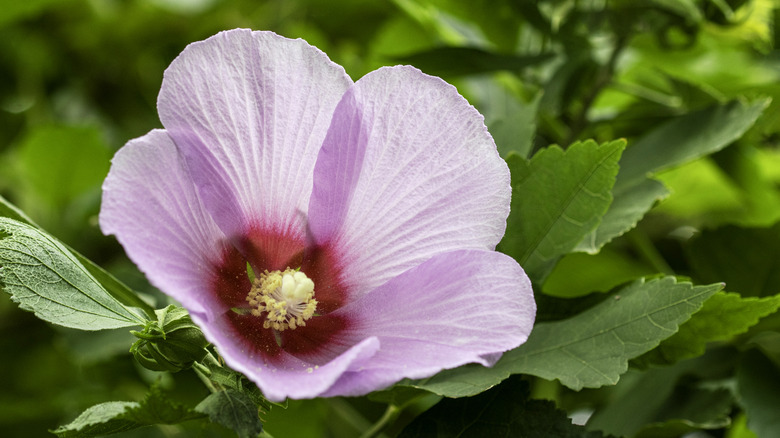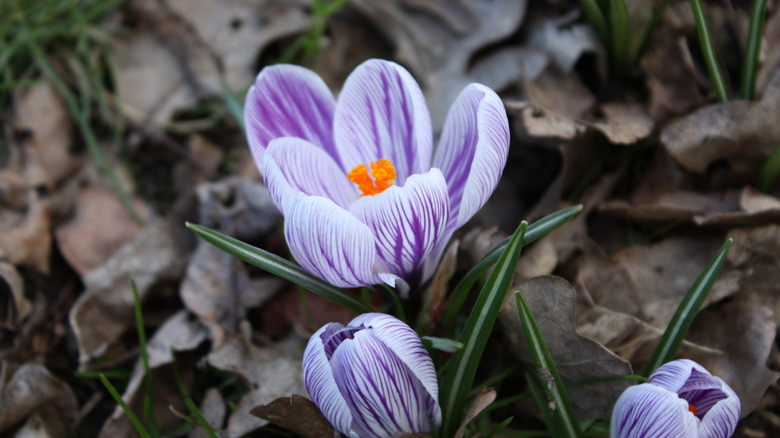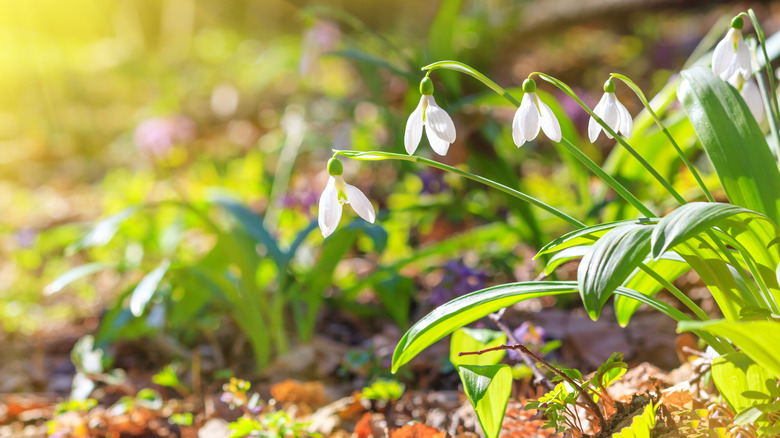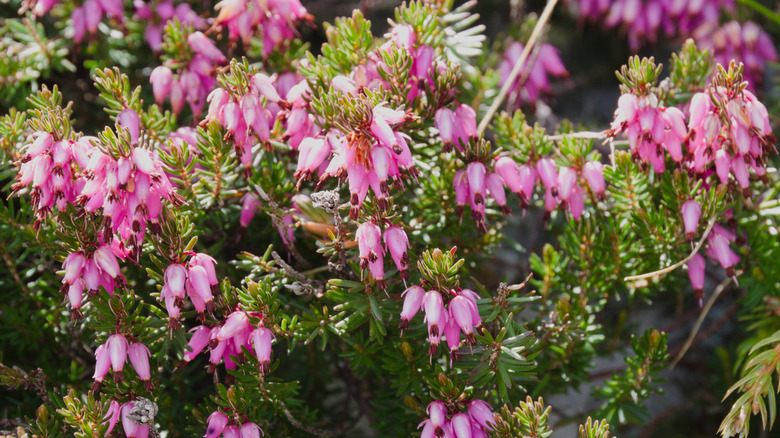17 Companion Plants That Pair Beautifully In The Garden With Anise Hyssop
Companion plants that pair beautifully in the garden with anise hyssop can help transform an ordinary planting bed into an amalgamation of gorgeous blooms. Anise hyssop (Agastache foeniculum) is one of the most adaptable perennials available. Thriving in USDA Hardiness Zones 4a to 8b, this flower enjoys full sun or partial shade, and loamy, sandy, or shallow rocky soil. It also tolerates a range of moisture conditions from moist to occasionally dry. This purple plant will fill your garden with hummingbirds and butterflies thanks to its tall, unscented spikes of nectar-rich blooms, which ensures that you'll benefit from having a diverse range of colorful visitors as well as having a garden that blossoms in color each year.
Creating a garden with layered planting increases bloom coverage, which makes your garden look fuller, but you'll need complementary plants that will bloom both at the same time as your anise hyssop and during times when it's dormant. When you pair anise hyssop with other perennials that share its growing preferences — such as borage (Borago officinalis) and purple coneflower (Echinacea purpurea) — they become part of a garden that may be beautiful to look at, but only blooms in summer and fall. To ensure that you create a garden that flourishes all year, you also need plants that will bloom when your anise hyssop is sleeping through the winter and spring. For example, winter heath (Erica carnea) and woodland crocus (Crocus tommasinianus).
Catnip
Catnip (Nepeta cataria) is a companion plant for anise hyssop that flowers in spring, summer, and fall. This aromatic perennial grows best in zones 3a to 9b, full sun to light shade, and prospers in sandy or loamy soils with good drainage. While catnip is well-known to appeal to cats, it's the soft lavender flowers of the plant that make it an ideal partner for flower beds that already contain anise hyssop. Mixing purple and purple-blue blooms together can create a vivid and pleasing aesthetic for your garden. But, in case you're wondering, anise hyssop is also considered safe for cats.
Nasturtium
Nasturtium (Tropaeolum majus) is an annual with edible blooms and leaves that will add plenty of visual appeal to garden beds where anise hyssop is already planted. This trailing or mounding annual blooms in spring, summer, and fall when planted in full sun with well-drained sandy or loamy soil, and its bold orange, red, and yellow flowers ensure that your garden benefits from beautiful guests as well as beautiful flowers. Nasturtium also deters insect pests.
Sweet Woodruff
Sweet woodruff (Galium odoratum) offers a fragrant, shade-tolerant ground cover that complements the upright form of anise hyssop in partially shaded gardens. This low-growing perennial grows best in moist, well-drained sandy soils in zones 4a to 8b, and spreads to form a dense mat of foliage. Its delicate white flowers bloom in early spring and can suppress weeds below taller plants. Its sweet scent ensures that you will have a fragrant garden, and together with hyssop, sweet woodruff gives you the chance to plant some seasonal layering in your garden.
Lanceleaf coreopsis
Lanceleaf coreopsis (Coreopsis lanceolata) brightens gardens with cheerful yellow blooms that appear from spring to early summer. This sunshine perennial will grow well in any flower bed in zones 4a to 9b where it can get full sun for at least six hours a day, and stretch its roots in sandy, loamy, or shallow rocky soils that have good drainage. Its early-season flowers have plenty of value in gardens, and its ability to self-seed is perfect if you're looking for low-maintenance plantings. This perennial also tolerates drought once established.
Ornamental onion
Ornamental onions (Allium spp.) are low perennials that can be used as a variety of groundcover in zones 4a to 9b, provided they have access to full sun and well-drained sandy or loamy soils. Its globe-shaped flower heads — ranging from deep purple to soft white — bloom in late spring to early summer. Because it's an allium, this plant grows from a bulb that can be divided every few years to fill your garden with more beauty.
Blue anise sage
Blue anise sage (Salvia guaranitica) makes an ideal companion for anise hyssop in various gardens, offering abundant, reliable blooms from midsummer through frost. This upright perennial thrives in full sun to partial shade and prefers well-drained, but still moist soils — conditions that match well with anise hyssop's flexible growing needs. There is enough crossover with its preference of zones 7b to 10b to match anise hyssop's preferences, and its blue or purple tubular blooms will look striking next to any anise hyssop you have planted.
Wild bergamot
Wild bergamot (Monarda fistulosa) pairs naturally with anise hyssop thanks to its similar cultural needs. This native perennial enjoys gardens in zones 3a to 9b, full sun to light shade, and adapts well to dry or moderately moist soils, including clay and shallow rocky types. Its lavender-pink blooms appear throughout summer, and wild bergamot also contains aromatic compounds that help deter wild deer and rabbits, so you don't have to worry about your beautiful plants being eaten. Although this is a flower that isn't worth growing from seed, it contributes to a resilient, fragrant, and rich garden habitat.
Southern bush honeysuckle
Southern bush honeysuckle (Diervilla sessilifolia) adds structure and texture to any garden anchored by anise hyssop. This compact, shrub-like native perennial isn't a true honeysuckle, but it offers clusters of yellow summer flowers without becoming invasive. Unlike many flowering shrubs, it can grow in full sun or partial shade, but does need some sun in any situation. It tolerates zones 4a to 8b, dry, rocky, or loamy soils, and requires little maintenance. It helps create a layered garden that's both rugged and refined, thanks to its 3 to 5 foot spread in width and height.
English lavender
English lavender (Lavandula angustifolia) is a fragrant perennial that is a suitable bedmate for gardens with anise hyssop in zones 5a to 9b. This drought-tolerant, sun-loving dwarf shrub flourishes in sandy or well-drained loamy soils and can even grow in dry, infertile soil. Its aromatic purple flowers bloom in summer, and though it performs best in full sun, it requires little care once established. When combined with anise hyssop's vertical form and late-season blooms, lavender provides a type of ground cover that enhances both the visual balance and ecological value of any garden.
Borage
Borage has continuous blooms that offer bright colors from summer into fall with its vivid blue, star-shaped flowers. This annual herb likes full sun and well-drained sandy or loamy soils, matching anise hyssop's preferred growing conditions. Borage is resistant to poor soil and is known to deter pests, making it both beautiful and beneficial for gardens. Its self-seeding habit ensures reliable regrowth, and, along with anise hyssop, it's one of 27 herbs you should grow to attract more hummingbirds to your garden if you want to encourage beautiful birds to visit.
Anise goldenrod
Anise goldenrod (Solidago odora) gives your zone 4a to 9b garden late-season color and ensures that there is nectar when other summer blooms fade. This native perennial thrives in full sun to light shade and grows well in sandy or loamy soils with good drainage, making it an excellent match for hyssop's preferences. Its fragrant, golden flower spikes also tolerate dry periods once established, enhancing its value in specialty gardens that are focused on long-lasting seasonal interest. Its flowers smell like anise.
Purple coneflower
Purple coneflower gives any zone 3a to 8b garden lasting value when it's planted alongside anise hyssop because its large, daisy-like blooms open in mid-summer and flower well into fall (usually until the weather turns frosty). Purple coneflower is a sun-loving native perennial that can grow in sandy or loamy soil and handles both dry and moderately moist conditions. Paired with the spiked form of anise hyssop, this coneflower builds visual contrast and extends your garden's flowering season further into the year.
Spotted Beebalm
Spotted beebalm (Monarda punctata) energizes zone 3a to 8b gardens with its unique layered blooms and high ecological value. Its pale yellow flowers, ringed with purple spots and pink bracts, bloom in late summer and fall — just as many spring nectar sources begin to fade. Spotted beebalm is a perennial that grows well in sandy or loamy soils under full sun, and can moderately tolerate drought once established. Paired with anise hyssop's upright form and lavender blooms, spotted beebalm strengthens the appeal of your garden.
Swamp rose mallow
Swamp rose mallow (Hibiscus moscheutos) adds beautiful, bell-shaped blooms to gardens with anise hyssop. This perennial prefers zones 4a to 9b, full sun and moist, loamy or sandy soils, but it will suffer from leaf scorch if left in dry soil. Its large, showy flowers — ranging from white to pink with deep red centers — bloom throughout summer to early fall. Though it's more often found in wetland, it grows well in regular garden beds that meet its cultural conditions. Paired with hyssop, it adds some additional flair, habitat value, and late-season floral abundance to your yard.
Woodland crocus
Woodland crocus fills a vital gap in gardens by blooming when few other plants do in late winter to early spring, especially in gardens in zones 3a to 8b. This perennial bulb prefers full sun to partial shade and sandy soil. Its lavender to red-toned petals open on cold days to ensure that you're never without a beautiful flower in your yard. When paired with summer- and fall-blooming anise hyssop, your garden will have color almost all year (with short gaps while flowers grow and bloom).
Common Snowdrop
The common snowdrop (Galanthus nivalis) also offers delicate, dependable blooms that appear in late winter and early spring, much like the woodland crocus. This makes them an excellent late-blooming companion plant for anise hyssop if you don't want a zone 3a to 9b garden that's bare of flowers in colder months. Plant snowdrops in partial shade or full sun and ensure they have moist, well-drained loamy soils to root in. Snowdrops grow well in woodland gardens, especially under trees that shed their leaves each year.
Winter Heath
Winter heath brings a pop of color to any winter garden when few other plants are flowering. This filler plant displays its flowers from late winter into early spring and performs best in full sun with sandy soils that drain well. Its low form and evergreen foliage make it ideal for edging borders in zone 7a to 9b gardens. Paired with anise hyssop and any of the other companion plants listed above, you can easily strengthen the seasonal diversity of the flowers in your yard and make it a place that is blooming with color all year round.
